
History Makes Movies Better
There are 365 days in a normal non-freaky-leap year. Each of those days marks the anniversary of all sorts of crazy shit. Some of that crazy shit has been made into movies.
April 2
498 years ago, today, a plucky adventurer named Ponce de León spotted a landmass he believed to be another island (having just visited the Bahamas). In recognition of the lush landscape and the Easter season – which the Spaniards called “Pascua Florida” (Festival of Flowers) – Ponce named what later turned out to be a flaccid penis shaped peninsula, “La Florida.” While doing some Age of Exploration films would be fun, this month is the 150th anniversary of the Civil War, so I’m going to go a slightly different seafaring direction.
On this day, 148 years ago, the US Navy’s first commissioned submarine – the Alligator – was lost in a storm.
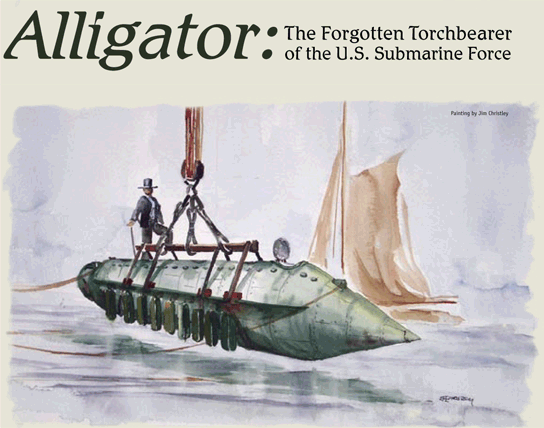
The Alligator was not the first submersible craft to fight in an American war. The Turtle was created by American inventor David Bushnell for the hypothetical purposes of attaching bombs to British ships during the Revolutionary War, but the craft was not officially part of the military. It was also acorn shaped and held but one passenger. But the idea of a ship hidden beneath the waves was an intriguing one (one being experimented with by most world powers), and in 1861 the US Navy commissioned the Philadelphia ship building company Neafie & Levy to construct a ship designed by French engineer Brutus DeVilleroi. The Alligator – as it was informally named by a newspaper reporter who saw its creepy green impression skimming the surface of a river – launched in May of 1862, at first powered by an archaic rowing system, but the Navy quickly replaced the paddles with a faster high-tech screw propeller, powered manually by a hand crank.
Unlike the Turtle, the Alligator resembled modern day submarines in its basic shape, and it carried a 14-man crew. It was also the first submarine to utilize compressed air and to feature an air filtration system. There was mixed debate among Navy officials about what exactly the Alligator would/could be used for, and an early test run of its capabilities left its commander Lt. Thomas O. Selfridge, Jr. underwhelmed. Sadly for the Alligator, it never got a chance to prove itself or even fail in battle. On April 2, 1863, the Sumpter – the ship towing the Alligator – was forced to cut the Alligator loose when they encountered a violent storm off Cape Hatteras. The Alligator sank.
But the principals behind the submarine were too tactically appealing to stop there, and by WWI, submarines were a major player in naval warfare. And a major player in cinematic warfare too.
Up periscope!
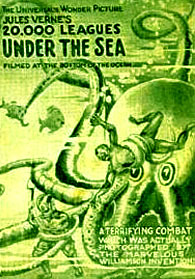 20,000 Leagues Under the Sea (1916)
20,000 Leagues Under the Sea (1916)
This silent film from Universal, back when they were called the Universal Film Manufacturing Company, combines Jules Verne’s classic tale – about an American ship sunk by a “sea monster” that turns out to be a submarine called The Nautilus, commanded by the brilliant but slightly mad Captain Nemo – with another Verne tale, The Mysterious Island. The film was incredibly expensive, using actual locations, gigantic sets, a full-scale and navigable exterior for the Nautilus, and most impressive for the era, underwater photography. No underwater cameras were designed or used, but rather a clever system of watertight enclosures and mirrors allowed above-water cameras to shoot reflected images of the underwater action. Though popular, the sheer size and budget of the film made it somewhat of a failure. An oft adapted tale, another notable film version came from Disney and director Richard Fleischer in 1954, starring Kirk Douglas and James Mason.
.
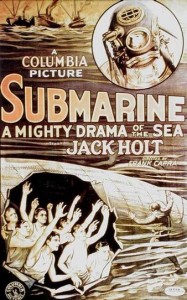 Submarine (1928)
Submarine (1928)
This silent film by Hollywood legend Frank Capra, tells the tale of Jack Reagon (Jack Holt), a Navy man who falls for a dance-hall gal, Bessie (Dorothy Revier). They marry, but Bessie proves to have a wandering eye and a love affair brews between Bessie and Reagon’s Navy pal Bob (Ralph Graves). When Bob and the rest of his crewmates become trapped underwater in a sunken submarine, Bessie admits her unfaithfulness to Reagon. Now Reagon must rescue his old friend. Submarine proved a big hit, so – as was typical at the time – Carpa and actors Holt and Graves reteamed for two carbon copies about a love triangle that ends with Holt bravely saving his friend/rival from a wreck; Flight (1929) and Dirigible (1931).
.
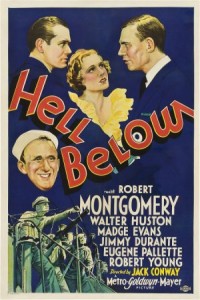 Hell Below (1933)
Hell Below (1933)
Submarines and cuckolding mix again in this film from director Jack Conway. Lt. Tommy Knowlton (Robert Montgomery) falls in love with Jean Standish (Madge Evans) while on leave in Italy. Not only is the lady married, but she is the daughter of Knowlton’s submarine commander, Toler (Walter Huston). Friction between Knowlton and Toler rises once at sea, especially after Toler abandons one of Knowlton’s friends topside when the sub is forced to make an emergency dive. The film also features supporting roles from the iconic big-nosed comedian Jimmy Durante and classic Disney voice regular Sterling Holloway.
.
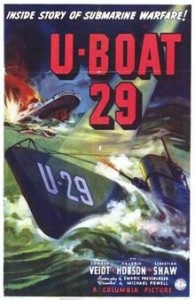 The Spy in Black (1939)
The Spy in Black (1939)
This British film, released as U-Boat 29 in the States, marks the first collaboration of director Michael Powell and screenwriter Emeric Pressburger, who would have a long and successful reign in the British film industry, producing such notable classics as Black Narcissus. The film follows Captain Hardt (Conrad Veidt), a WWI German u-boat commander who plans to lead an attack on a British Fleet off the coast of Scotland. He puts ashore on a Scottish island to meet with his contact but finds himself tangled up with a local schoolmistress (Valerie Hobson). The film also stars Sebastian Shaw, a famous British stage actor who is now most famous for portraying the original Anakin Skywalker in Return of the Jedi.
.
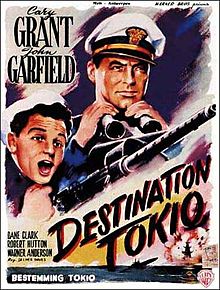 Destination Tokyo (1943)
Destination Tokyo (1943)
The Hanging Tree‘s Delmer Daves helms this WWII adventure film centering on a submarine crew led by Capt. Cassidy (Cary Grant). Cassidy and his men are sent to infiltrate enemy waters off Tokyo to gather weather intelligence for the upcoming Doolittle Raid (the first Allied bombings of the Japanese mainland). Both this film and alternately another 1943 submarine film, Crash Dive, are often sited as Tony Curtiss’ inspiration for requesting submarine duty when he joined the Navy. If there is truth to the story, then Grant and Curtis surely must have had a chat about it when they starred in Blake Edwards submarine comedy Operation Petticoat (1959). Grant’s performance also apparently inspired Ronald Reagan to take the role of a submarine commander Hellcats of the Navy (1957). Albert Maltz, one of the film’s screenwriters, was later brought before HUAC on the charge that some lines of dialogue in the film reflected Communist sympathies.
.
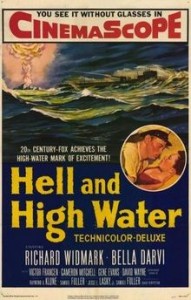 Hell or High Water (1954)
Hell or High Water (1954)
In this Samuel Fuller film – which he begrudgingly accepted as a favor to Darryl F. Zanuck, who had who stuck up for Fuller against J. Edgar Hoover when the FBI director attacked Fuller’s film Pickup on South Street – Richard Widmark stars as Adam Jones, a former Navy submarine captain, who is hired by Professor Montel (Victor Francen) to take charge of a civilian financed mission to follow a Chinese ship to into arctic waters, where Montel believes the Chinese are testing an atom bomb. Despite the superstitious crew’s complaints, Montel brings along his sexy assistant, Professor Denise Gerard (Zanuck’s mistress, Bella Darvi).
.
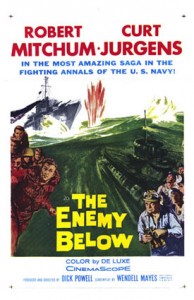 The Enemy Below (1957)
The Enemy Below (1957)
This rare directorial effort from actor Dick Powell is a good ol’ military face-off film. The story follows the battle between an American sub, commanded by Captain Murrell (Robert Mitchum), who has just recovered from the sinking of his previous ship, and a German U-boat commanded by Kapitän von Stolberg (Curt Jürgens). As with any good face-off film, each commander grows to respect his opponent in true nemesis fashion. Some feel that the classic 1966 Star Trek episode “Balance of Terror” is based on this film, with the Enterprise filling in as the American sub and the Romulan vessel as the U-boat.
.
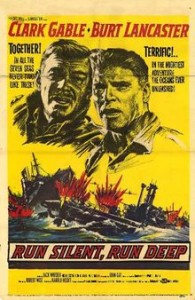 Run Silent Run Deep (1958)
Run Silent Run Deep (1958)
Robert Wise’s adaptation of the novel by Edward L. Beach, Jr. – who was a highly-decorated United States Navy submarine officer at the time – is a thematic revamp of Moby Dick, with a Japanese destroyer standing in for the white sperm whale. Not unlike Robert Mitchum’s character in The Enemy Below, Cmdr. ‘Rich’ Richardson (Clark Gable) had his previous sub sunk. But he is significantly bitterer about it, determined to get revenge on the Japanese destroyer that sunk him. His Ahab-like pursuit worries his crew, particularly his executive officer Lt. Jim Bledsoe (Burt Lancaster). Mutiny is in the air. Jack Warden and Don Rickles also co-star.
.
 Around the World Under the Sea (1966)
Around the World Under the Sea (1966)
This dopey Verne-lite adventure film follows a special submarine on a special mission to circumnavigate the globe, planting sensors on the ocean floor to help predict the devastating earthquakes plaguing civilizations worldwide. A frequently shirtless Lloyd Bridges leads up a similarly shirtless cast of other dudes, with inter-sub conflict caused personal issues — some due to the presence of Shirley Eaton (most famous for getting covered head-to-toe in gold paint for Goldfinger). Keenan Wynn also co-stars.
.
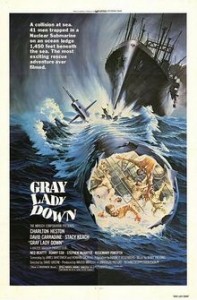 Gray Lady Down (1978)
Gray Lady Down (1978)
Before Black Hawk Down there was Gray Lady Down, and no, it’s not a film about The New York Times shutting down. It’s about an old submarine commander, Captain Paul Blanchard (Charlton Heston), who is on his final tour before getting promoted. Of course, as Movie Law dictates, something horrible always happens on your last day at any job, so Blanchard’s sub is accidentally struck by another ship, sending it to the bottom of the ocean. Captain Bennett (Stacy Keach) heads up a rescue mission, but Blanchard’s sub gets knocked even deeper by an avalanche. Now, only the maverick commander of an experimental new sub, Captain Gates (David Carradine) can save the day. Ned Beatty, Ronny Cox, and Christopher Reeve (in his first screen role) co-star.
.
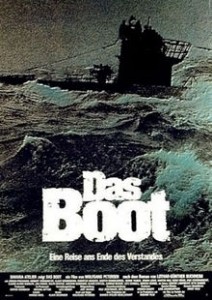 Das Boot (1981)
Das Boot (1981)
If any film can be considered the submarine movie, it would have to be this behemoth of cinematic achievement by Wolfgang Peterson. Still one of the most expensive German films ever made, Peterson wanted to take viewers on “a journey to the edge of the mind,” as the German poster’s tagline read. Based on the novel by Lothar-Günther Buchheim, the film depicts the trials of a German U-boat, commanded by Jürgen Prochnow, miraculously getting us to empathize with Nazis by treating them as regular, real human beings and showing the tedium of military life as well as the excitement and danger. In 1997, Peterson released a director’s cut that added an entire hour of cut footage.
.
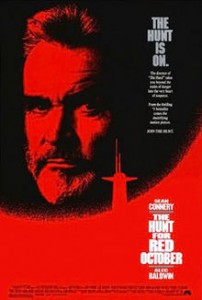 The Hunt for Red October (1990)
The Hunt for Red October (1990)
The Alec Baldwin franchise that almost was. John McTiernan’s adaptation of Tom Clancy’s novel concerns an ultra high-tech and undetectable new Russian sub – the Red October. The sub’s commander, Captain Marko Ramius (Sean Connery), goes rogue, abandoning his orders and heading for the American coast. When word of this reaches America, the government is in a panic to find and destroy the sub. But analyst Jack Ryan (Baldwin) believes that Ramius plans to defect to the US, not attack us. Now it is a race against time, as Ryan is sent to try and make contact with Ramius before another Russian sun (commanded by Stellan Skarsgård) can sink him. The all-star cast also includes James Earl Jones, Jeffrey Jones, Scott Glenn, Sam Neill, Richard Jordan, Tim Curry, Senator Fred Thompson, the not-talked-about-enough awesomeness that is Joss Acklund, and action movie background player stalwart, Sven-Ole Thorsen.
.
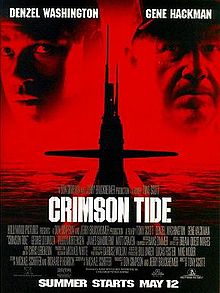 Crimson Tide (1995)
Crimson Tide (1995)
This movie and Red October have eerily similar posters, no? I guess they do have similar colors in their titles. In this Don Simpson/Jerry Bruckheimer joint, from director Tony Scott, contention boils over when Soviet rebels point some nukes at America. When a message for the nuclear-missile sub USS Alabama gets cut off during transmission, its commander, Captain Frank Ramsey (Gene Hackman), thinks he’s been ordered to launch a preemptive strike. Officer Lt. Cmdr. Ron Hunter (Denzel Washington) begs to differ. He thinks they’ve been ordered to stand down. Tensions run high. Crimson Tide has gained a slightly better foothold in cinema history ever since it was revealed that a pre-fame Quentin Tarantino had done uncredited rewrites on the script — suddenly making that weird conversation about Silver Suffer in the film make a lot more sense.
.
 U-571 (2000)
U-571 (2000)
Director Jonathon Mostow followed his b-movie surprise hit Breakdown with this b-movie WWII tale about American attempts to retrieve the Enigma encoding device that makes the German’s ciphering system unbreakable. The film stars Matthew McConaughey, Bill Paxton, Harvey Keitel, Thomas Kretschmann, David Keith, and pride of Jersey, Jon Bon Jovi, back when he was making a concerted effort to break into acting. The film caused a minor uproar in the UK upon its release, as apparently the Brits didn’t take kindly to us monkeying with their history. See, Enigma machines were a real thing, and the Allies acquisition of them was pretty critical to gaining supremacy at sea against the Germans. Here’s the other thing — of the 15 Enigma machines captured during WWII, 13 of those were captured by the British; many captured before the US even entered the war. The Canadians also got one. And we got one; in 1944, at which point the German codes had long since been cracked. USA! USA! USA!
.
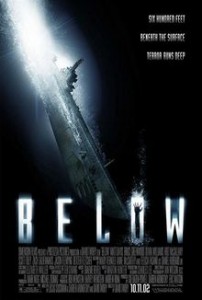 Below (2002)
Below (2002)
This horror thriller from director David Twohy – co-written by Darren Aronofsky – concerns a WWII American sub, commanded by Lt. Brice (Bruce Greenwood). Brice’s sub happens upon a downed British hospital ship with only three remaining survivors. After making rescue, the sub’s crew soon discovers that the Germans pursuing them may be the least of the their troubles. Cause it appears the ocean depths may be kinda haunted. Olivia Williams and a not yet famous (yet no less awesomely bearded) Zach Galifianakis co-star.
.